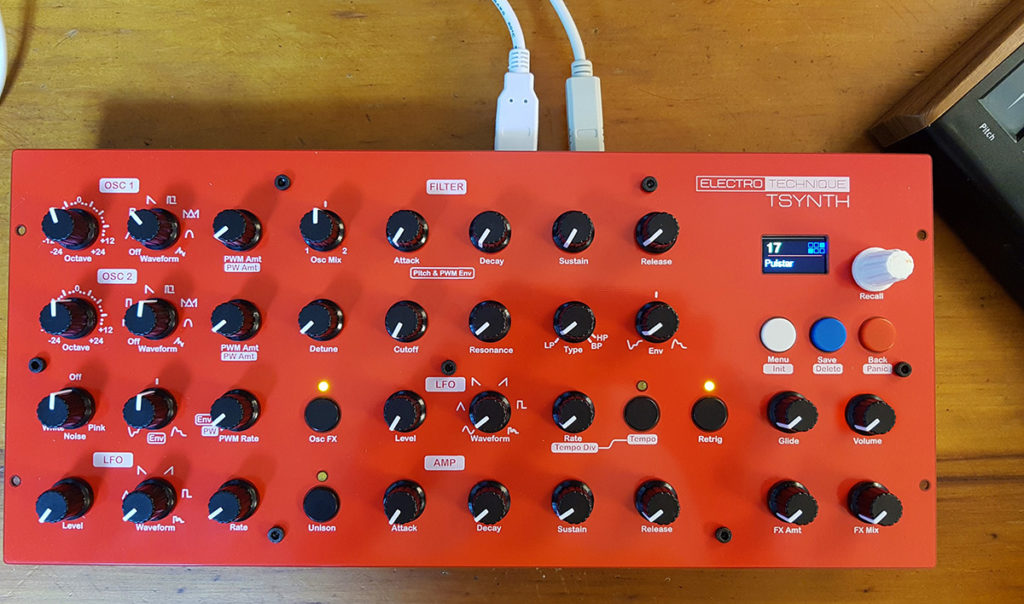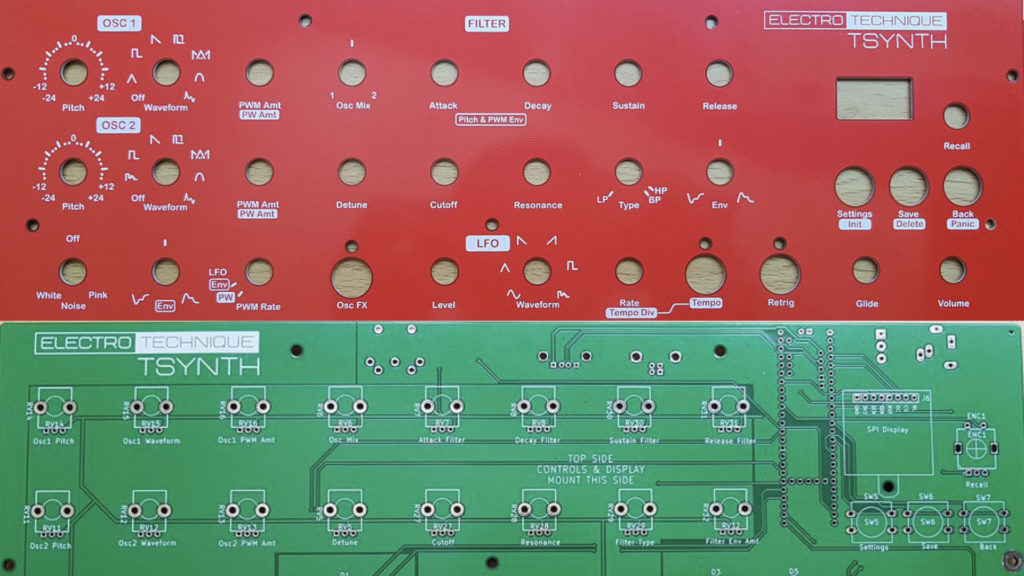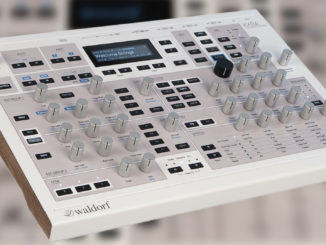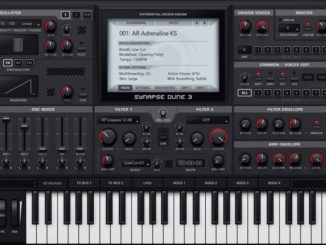Electro Technique TSYNTH is Teensy-based polyphonic Synthesizer that is open-source, powerful, and cost less than a plugin on average
In the summer I reported about the Electro Technique TSYNTH, a Teensy-powered digital polyphonic Synthesizer that you can build as a DIY project. The lovely project has been so successful in the DIY communities that it has been constantly sold out. At the same time, the developer is working on a new version with the Teensy 4.1 with more power.
The good news: the new version is here, the bad one, it’s sold out again. The Teensy 4.1 version offers 12 voice polyphony with 2 oscillators per voice, individual LFOs, state variable filter, a stereo ensemble chorus effect, and more. Thanks to the new core, the TSynth handles the polyphony better and is more powerful overall. A nice Synthesizer and DIY project. Hope the delivery times will improve in the future.
News From July 12, 2020
A weekly look at the DIY platform Tindie is always worthwhile, especially if you are looking for a nice DIY project. The South Korean developer Electro Technique introduced TSYNTH, an open-source polyphonic Synthesizer based on the Teensy board. For this purpose, they have developed a PCB on which the tiny Teensy is attached but also where all controllers of the synth are located. It has plenty of controls for a $99 synthesizer project: 33 knobs, 6 buttons, and a small screen.
TSYNTH is a pure DIY project. From the developer, you get the PCBs, display, and a 3D printed standoff for the display. Small parts like knobs, buttons, etc. have to be purchased from other shops. According to the developer, all of this will cost you around $99 what would be a great price for such a fully controllable synth.
TSYNTH Engine
The engine is pretty impressive: six-voice polyphony (last note priority) with two oscillators per voice (+2/-2 octave range detunable) including sine/S&H (like tuned noise), square, sawtooth, ramp, PWM, Var triangle, user waveforms to select from. Further, there is pulse width/var triangle for each oscillator with a dedicated LFO or filter envelope, pink/white noise, pitch mod, XOR (ring mod), unison, and polyphonic glide with variable time.
On the filter side, it comes with a state variable 12dB filter (SVF) with a continuous mix between LP and HP (provides notch filter) and BP. A bit like an Oberheim SEM filter. The cutoff can be modulated by a dedicated ADSR envelope (+/-) or LFO. The latter has the same waveforms as the pitch LFO (can be retriggered by note on) and rate can be set to match MIDI clock (tempo) with variable time-division.
Further, there is a dedicated ADSR envelope for the amp and an effect section with a stereo ensemble chorus. The synth has a built-in USB host connection that allows you to connect a MIDI controller via USB with no PC/Mac required. Plus, it has a MIDI in via 5 pin DIN. It also includes a built-in audio interface that is based on an SGTL5000 Audio Shield 16bit, 44.1kHz stereo.
The synth comes with a programmer that allows you to save/recall patches but also to update it with new user waveforms, new features (alternative filters, effects, parameters…), and firmware updates.
Sold Out Why?
The first batch of TSYNTH is sold out but there is one main reason why it’s sold out. The developer has announced that Teensy 4.1 was recently released. This information is important because the synth is based on the previous version of Teensy (3.6). So the PCB doesn’t support the new version so the developer decided to update the main PCB of it with a new firmware. The new version will offer more polyphony (16), quicker note on response, and MIDI thru. A nice upcoming update for TSYNTH which will probably be released later this year.
At first glance, an impressive DIY Synthesizer with many features that can be operated without sub-menus and a great sound for little money.
The TSYNTH PCB and front panel kit will be available from the Electro Technique Tindie shop for $36 USD that includes SMD 4067 multiplexers, 6N138 opto-isolator, capacitors, and resistors fitted. The other parts must be purchased from other shops. Plans for a 3D printed/laser cut enclosure will be available soon. The synth with all the components will cost you around $ 99 in the end.
More information here: Electro Technique






Honestly, as such DIY projects go, this one is rather impressive. A certain attention to details as well as a nice integration of diverse features, quite a winning combination even for a commercial product coming from a full R&D team. For instance, the polyphonic glide demoed in the orchestra patch is quite revealing. It also sounds like the overall device is quite fun to use. Plugging controllers through USB is one of the showcased features of the Waldorf Iridium (rumoured to be “affordable”, revealed at 2k€).
Soooo… If this were released commercially as a piece of pre-built hardware, it could gain quite a bit of traction.
Wouldn’t say that the sound is mindblowing. That can be solved with just a bit of FX, as what happens on the (monophonic) Korg Nu:Tekt NTS-1.
Waste of time reporting this, the batches are inconsistent and tiny, they disappear Within minutes And the waiting list is nearly 5000, ive been on the waiting list for 7 months no sogn og getting one. Its vapor-ware.
we talk about vaporware when the product doesn’t exist. In this case, there are far more pre-orders than available units.
Plus the developer is a one-man show like me and does not have the resource to create more. He states on the website that he search
a partner.
Many thanks for the feature. Yes the synth indeed exists. The waiting list isn’t quite 5000! About 500 and buyers are gradually receiving stock. As I’ve said elsewhere, this isn’t my main occupation and dropping everything to run it as a company to fulfill orders would be foolish and difficult in a country where I am a foreigner.
I am currently looking for resellers to receive stock directly and distribute in their own country.
Thanks for putting this together, sounds like a fun project and clearly a successful one.
Would be cool to be able to get an assembled, ready-to-go unit, for the people with null soldering skills like me. Even with a logical price increase, of course.
is it a true 12 voice polyphonic ie 2osc 1fiter 2 envelopes per voice